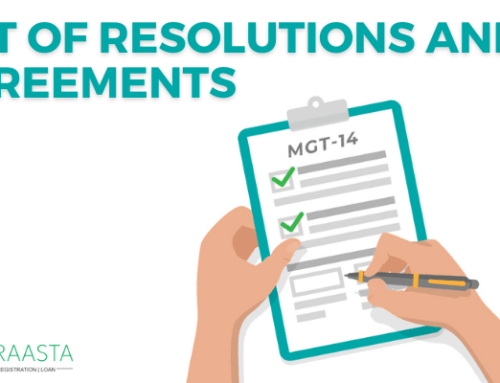To operate, diversify and expand, a company needs funds. It may finance the various projects through its share capital and borrowed funds. The borrowed capital can be raised by the issue of debentures or by obtaining financial assistance from the Bank or even other Financial Institutions that have NBFC Registration. To securitize these loans, some assets of the company are mortgaged with the bank. This way the financial institutions get a surety that their funds are safe and would be repaid along with the principal amount & interest. For securing their funds they resort to creating rights on the assets of the borrowing companies, which is known charge creation on assets.
If a company is unable to repay its debts or loans, then the bank or financial institution can take possession of the assets secured and conduct a sale, to recover the funds.
The borrower companies are required to file the requisite particulars with the Registrar of Companies (ROC) for all such securities created over its assets. This process of creating security over assets of the company is identified as registration of charges or the creation of charges.
Charges
Contents
A charge is a right created by the borrower company on its assets and properties, in favor of the lender, a bank or a financial institution. These properties may be present or future, tangible or intellectual property, (these may be Trademark, Copyright or Patent in India). Most companies borrow funds from banks and NBFC to finance the short-term and long-term capital required for their operations. To secure these funds, lent to the company, the lender institutions need a number of legal documents like loan agreements, hypothecation agreements, mortgage deeds, etc. These lay out the terms of the loan and ensure repayment with interest as per the agreed terms.
In order to keep a check that the same assets are not used as security for borrowing from a number of banks or financial institutions, all this information needs to be filed with the ROC. The charges on a company’s assets can be easily accessed on the MCA website. This way the lender institutions can track the assets pledged by a particular company, and the loans provided. In other words, the process of charge creation of a company helps lenders know the other lenders of that company and the assets pledged to them. It helps to save the financial institutions by avoiding double financing a company and the loan amount.
Types of Charge Creation
Initially, only 9 types of charges were specified to be registered under Section 125 of the Companies Act 1956. Later, Section 77 of the Companies Act 2013 has expanded the scope. Therefore, now the Companies need to register all charges, with the ROC within 30 days of its creation.
- whether in India or abroad,
- on property or assets of a company or any other company registration done as its undertaking/subsidiary/sister concern,
- whether on tangible or intangible property.
For Charge Creation, Form CHG-1 is required to be filed with the ROC within 30 days. The Form must be signed by the Company and the Charge-holder. It has to be filed along with the instrument creating the charge.
Modification of Charge
Provisions for Modification of charge are exactly the same as the provisions for Creation of Charge. Once the form for Modification of Charge has been filed, the ROC will issue a certificate for Modification of Charge in Form CHG-3.
Any change in the terms, conditions, the extent or operation of any charge pre-registered under also require registration.
Satisfaction of Charge
A Charge is created as a security for loan or debentures or as a security for some other purpose. When the amount has been fully paid and other purposes have been fulfilled, there remains no necessity of the charge. This is termed as Satisfaction of Charge.
As per Section 82, the Form CHG-4 has to be filed for Satisfaction of Charge. And the duration is within 30 days of the Satisfaction of the Charge. If the company fails to file form CHG-4 within the time limit, then the company will have to go for condonation of delay.
Process of Charge Creation/Modification
The company has to authorize, through Special Resolution, its Board of directors, to borrow funds as required by the company and that this is done through creating a charge on the assets and properties of the company. Authorize them to provide security to the lending banks or financial institution with NBFC license for repayment of the borrowings. And to exercise this authority, they may execute the loan and other required documents. These provisions come under Section 180 of the Companies Act 2013.
Once the charge has been created, the directors need to get it registered with the ROC. The procedure as specified under Section 180(3)(c) of the Companies Act 2013, need to be undertaken.
When the Special Resolution has been passed, as required under the Companies (Management and Administration) Rules, 2014, Form MGT-14 is to be filed with the registrar.
- Organize a Board meeting, concluding in a decision, to avail the loan and securitize the Charges or assets. During the meeting, the authority to execute necessary documents must also be given.
- File Form MGT-14, accompanied by the said resolution with the ROC, within 30 days of its passing.
- Execution of the necessary documents for availing the funds on loan and the security being provided.
- Once the charge has been created or any modification has been completed. File Form CHG-7, to make entries in the register of Charges maintained. It must be authenticated by the Director or Secretary of the company or a person as authorized by the board.
- Either Form CHG-1 (for other than debentures) or Form CHG-9 (for debentures including rectification) is to be submitted. Pay the fee, as applicable. This step must be completed within 30 days from the date of charge creation/modification.
- Attach the following documents:
- A certified true copy of every instrument evidencing all charge creation or modification.
- If a Joint Charge or Consortium Finance has been undertaken, then the particulars of other charge holders or lenders.
- The Instrument that evidences creation or modification of charge, in case of acquiring property which is already a subject to some other charge. And the Instrument evidencing such acquisitions.
- After a proper examination has been conducted, the ROC shall issue a Certificate of Registration. Form CHG-2, if the charge has been registered under section 77(1) or 78. Form CHG-3, if the charge is registered under section 79.
- In case of a modification of charge, Form CHG-3 is to be obtained from the ROC.
- When the Form CHG-1 or Form CHG-9 has not been submitted within the period of 30 days. They can be submitted within the period of 300 days, with an Application for Condonation in Form CHG-8 or Form CHG-10, respectively. They are to be submitted with the Regional Director having territorial jurisdiction over the registered office of the company under The Companies Act, 2013.
- Form CHG-8 or Form CHG-10 are to be enclosed with a Declaration by the Secretary or Director of the company that delays shall not affect the rights of the creditors.
- Pay the penalty as imposed by the Regional Director. Generally, a period of 15 days time is given to pay this penalty.
- After the payment of the imposed penalty, submit the Challan with the Regional Director’s office. It must be enclosed with a letter requesting issue an Order allowing Condonation of delay.
- Submit the Order of Condonation with the ROC within the stipulated time given in the order itself with Form INC-28.
- Once the ROC has approved the Form INC-28, get approval for the Form CHG-1 or CHG-9, whichever is applicable.
- Once due compliance has been met with, the ROC shall issue Certificate of Registration in Form CHG-2, if the charge has been registered under section 77(1) or 78. Or Form CHG-3, if the charge has been registered under section 79.
Duration for filling for Creation of Charge
Within 30 days The Application has to be filed within 30 days of the Creation of Charge in Form CHG-1.
Between 30-300 days The Application needs to be filed before the expiry of 300 days from the Creation of Charge in Form CHG-10 attached to Form CHG-1.
After 300 days The Application for Condonation of Delay to Regional Director in Form CHG-8.
Effect of Non-Registration of Charge
As per Section 77(3), when the charge has not been created or registered with the ROC. Such charge shall not be taken into account by the liquidator or any other Creditor. And that mere filing of the charge with the ROC is not sufficient. Due process has to be maintained and it has to be registered by the ROC and a Certificate of Registration must be received.
However, the liquidator and creditors come into the scene only in case of wind up. The obligation to repay the loan remains there even if the charge was not registered, for all other cases. The contract of securitizing the property is still valid, u/s 77(4).
Penalty for Non-Filing
If a company is found to be violating any provision of this Section, it shall be punishable with a fine of not be less than Rs. 1 lakh and which may extend up to Rs 10 lakh. Furthermore, every officer in default shall be punishable with a fine of not less than Rs. 25,000 and may extend up to Rs. 1 lakh, or with imprisonment for up to 6 months, or both.
For specialist advice related to your specific circumstances and business loans, visit our website LegalRaasta. India’s most followed portal for all services related to companies, legal or financial. Our services include Trademark Registration, FSSAI Registration, and ISO Certification. We also have the most updated GST Software, Inventory Management Software, etc.
Call us at +91 8750008585 or send your queries to [email protected].
Or you can download our LegalRaasta APP for easy access on mobile.
Also go through:








